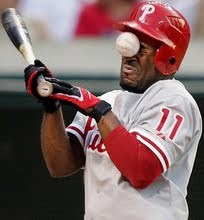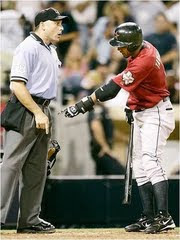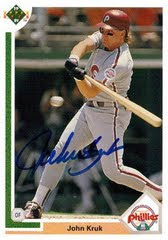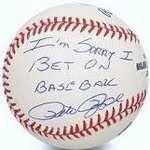 In 2008, Max Scherzer broke into the major league scene, along with Clayton Kershaw, as one of the minor league's top pitching prospects. As would be expected of a #11 overall pick with 3 pitches, including a quality mid-90s fastball and a nasty mid-80s power slider, Scherzer required little seasoning (less than two years) in the minors before making it to the bigs. From the get go, Scherzer made his name known. In his first major league appearance, Scherzer pitched 4.1 innings, striking out 7, allowing nobody on base. Amongst rookies to own that year, he was arguably hotter than king prospect Jay Bruce. He ended the season with a 145 strikouts in 109 innings split evenly between AAA and the majors; his MLB ERA was 3.09. His xFIP in the limited sample size, 3.19, screamed potential.
In 2008, Max Scherzer broke into the major league scene, along with Clayton Kershaw, as one of the minor league's top pitching prospects. As would be expected of a #11 overall pick with 3 pitches, including a quality mid-90s fastball and a nasty mid-80s power slider, Scherzer required little seasoning (less than two years) in the minors before making it to the bigs. From the get go, Scherzer made his name known. In his first major league appearance, Scherzer pitched 4.1 innings, striking out 7, allowing nobody on base. Amongst rookies to own that year, he was arguably hotter than king prospect Jay Bruce. He ended the season with a 145 strikouts in 109 innings split evenly between AAA and the majors; his MLB ERA was 3.09. His xFIP in the limited sample size, 3.19, screamed potential.Thus, 2009's results were not exactly the kind of numbers owners expected when they drafted him last year. From a fantasy perspective, the 174 Ks in 170.1 IP were great, but the 4.12 ERA, 1.34 and early season injury woes were less than Lincecum-like (though, mind you, Lincecum did notch 4.00 ERA and 1.28 WHIP during his rookie season) and far inferior to another young pitcher, Clayton Kershaw, who, through a lot of flyball luck, tossed 171 innings of 2.89 ERA baseball (with 185 Ks to boot).
On the surface, Kershaw looked like the better pick last season and Scherzer seemed merely serviceable. But anyone who reads this blog knows we preach looking beyond the surface when analyzing pitchers and hitters.
Whereas Clayton Kershaw, one of the majors most FB-happy pitchers last season, posted a much less pretty (but still valuable) 3.90 xFIP, Scherzer's peripheral talents (K/9, BB/9 and GB%) lent to a 3.88 xFIP. Whereas Kershaw got lucky with the HRs (his 4.1% HR/FB rate was the lowest in the majors), Scherzer was hampered by bad luck (68.7 LOB%, .323 BABIP).
In forecasting Scherzer's 2010 prospects, we first need a baseline from which to adjust. Because Scherzer's 2009 FIP (3.87) and xFIP (3.88) were essentially identical last season, picking between them as a baseline for 2010 is a moot task. As a big believer in xFIP, however, I would have sided with the later if necessary. In short, we'll use 3.88 as Scherzer's 2010 ERA baseline.
Using 5 year data from 2004 to 2008, The Hardball Times found that a pitcher who switched over from the NL to AL primarily saw changes in their K/9 rate (-0.57) and ERA (+0.41). Accounting for these factors and holding Scherzer's 2009 rates constant, this would give Scherzer an 8.62 K/9 and 4.29 ERA. Not exactly the step forward Scherzer owners are hoping for in 2010. However, there is hope.
In computing Scherzer's 2010 prospects, we do not only need to account for a change in league, but also a change in park dimensions and the quality of the defense behind him. Let's begin by accounting for the change in park dimensions. While one year park factor data is nice for seasonal statistic adjustments, one really needs a larger sample size to get a more accurate reading of a park's true effects on runs scoring. According to Baseball Reference's multi-year park factor data, Chase Field has inflated run scoring by 9%, while Comerica Park has inflated run scoring by 3%. Let's say that Max Scherzer pitches 180 innings in 2010; not unreasonable. With a league-change adjusted ERA of 4.29, that would mean Scherzer allows 85.80 runs to score. Scaled back from Chase Field to the hypothetical neutral field, this runs allowed total decreases to 78.72 runs. Adjusted for Comerica Park, this runs allowed total increases to 81.08.
Next, we need to account for the change in defense. Given the unknown defensive abilities of Scott Sizemore and Magglio's inevitable move from RF to DH, let's simply hold the Tigers defense as constant from 2009 to 2010. In 2009, the Tigers, collectively as a team, prevented 43.6 Fielding Runs Above Replacement (FRAR). The Tigers also played 1,447 innings of defense. That means the Tigers defense prevented a little over .03 runs per inning of play compared to the "league average" defense. In other words, over the course of 180 innings, the Tigers would prevent an additional 5.42 runs compared to the neutral context. Subtract this from the park adjusted runs allowed total from above and we get an expected 75.66 runs allowed from Max Scherzer in 2010. This would account for an expected ERA of 3.78.
Given the adjustment in strikeouts, Scherzer would accompany that 3.78 ERA with approximately 173 K's to boot. Given a fresh slate of luck and a better defense in Detroit, I would expect some improvement in Scherzer's 2010 WHIP (1.34 in 2009), so let's peg the over/under around 1.30. Sounds solid, right? So why isn't Max Scherzer getting any love?
Yahoo Sports ranks this production at #261 overall. In a 12 team league, that would make Scherzer a 21st round pick. That puts him in the company of such starting pitchers as Bronson Arroyo (#259), Ted Lilly (#260), Daisuke Matsuzaka (#262) and Kyle Lohse (#263). Ted Lilly, though awesome and underrated, is injured and injury prone at this point, while the other 3 pitchers just aren't that good and provide limited (if any) upside. Given his pedigree, peripherals and clear upside, it seems like Yahoo is giving Scherzer an awfully low ranking. By contrast, MDC (which I equate to the free market) values Scherzer as the #143 pick overall (as of 3/12/10, he has not been drafted before pick 120 or after pick 160). This puts Scherzer in the company of such starting pitchers as Jered Weaver (#132), Jair Jurjjens (#139), Brett Anderson (#149) and Scott Baker (#151). This makes more sense as guys like Weaver, Jurjjens and Baker offer similar value (trading upside for reliability and expectation) and Anderson, like Scherzer, is a " has potential, but still offers some risk" kind of guy like Scherzer (only with less K's and more GB's).
 In short, Max Scherzer is an underrated fantasy asset for 2010. According to Roto Authority's "what it takes to win" estimates for 2010, the average starting pitcher on your squad will should accumulate a 3.78 ERA, 181 K's and 13.67 Wins. Sounds an awful lot like Scherzer's 2010 outlook to me; who knows what will happen if he tops 200 innings.
In short, Max Scherzer is an underrated fantasy asset for 2010. According to Roto Authority's "what it takes to win" estimates for 2010, the average starting pitcher on your squad will should accumulate a 3.78 ERA, 181 K's and 13.67 Wins. Sounds an awful lot like Scherzer's 2010 outlook to me; who knows what will happen if he tops 200 innings.Oh, and he's got that two different colored eyes thing going on, a la David Bowie.







0 comments:
Post a Comment